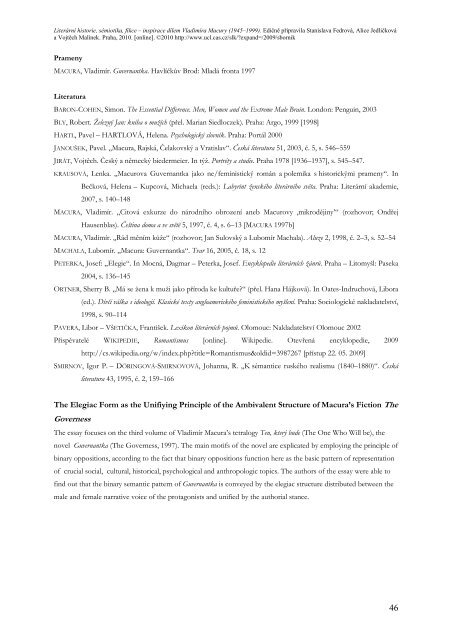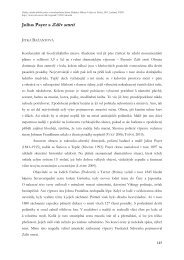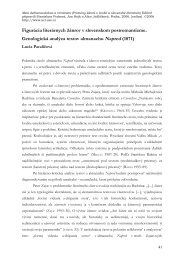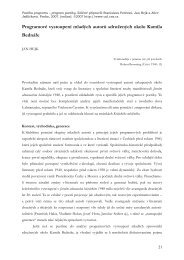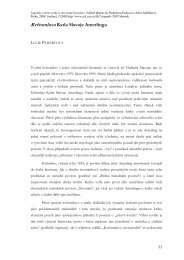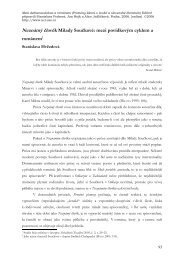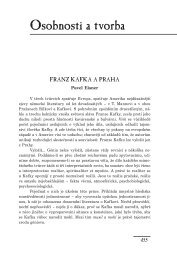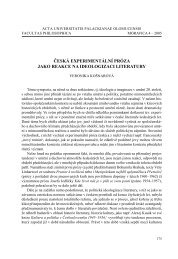Forma elegie jako sjednocujÃcà princip ambivalentnà výstavby ...
Forma elegie jako sjednocujÃcà princip ambivalentnà výstavby ...
Forma elegie jako sjednocujÃcà princip ambivalentnà výstavby ...
Create successful ePaper yourself
Turn your PDF publications into a flip-book with our unique Google optimized e-Paper software.
Literární historie, sémiotika, fikce – inspirace dílem Vladimíra Macury (1945–1999). Edičně připravila Stanislava Fedrová, Alice Jedličková<br />
a Vojtěch Malínek. Praha, 2010. [online]. ©2010 http://www.ucl.cas.cz/slk/?expand=/2009/sbornik<br />
Prameny<br />
MACURA, Vladimír. Guvernantka. Havlíčkův Brod: Mladá fronta 1997<br />
Literatura<br />
BARON-COHEN, Simon. The Essential Difference. Men, Women and the Extreme Male Brain. London: Penguin, 2003<br />
BLY, Robert. Železný Jan: kniha o mužích (přel. Marian Siedloczek). Praha: Argo, 1999 [1998]<br />
HARTL, Pavel – HARTLOVÁ, Helena. Psychologický slovník. Praha: Portál 2000<br />
JANOUŠEK, Pavel. „Macura, Rajská, Čelakovský a Vratislav“. Česká literatura 51, 2003, č. 5, s. 546–559<br />
JIRÁT, Vojtěch. Český a německý biedermeier. In týž. Portréty a studie. Praha 1978 [1936–1937], s. 545–547.<br />
KRAUSOVÁ, Lenka. „Macurova Guvernantka <strong>jako</strong> ne/feministický román a polemika s historickými prameny“. In<br />
Bečková, Helena – Kupcová, Michaela (reds.): Labyrint ženského literárního světa. Praha: Literární akademie,<br />
2007, s. 140–148<br />
MACURA, Vladimír. „Citová exkurze do národního obrození aneb Macurovy ‚mikrodějiny’“ (rozhovor; Ondřej<br />
Hausenblas). Čeština doma a ve světě 5, 1997, č. 4, s. 6–13 [MACURA 1997b]<br />
MACURA, Vladimír. „Rád měním kůže“ (rozhovor; Jan Sulovský a Lubomír Machala). Aluze 2, 1998, č. 2–3, s. 52–54<br />
MACHALA, Lubomír. „Macura: Guvernantka“. Tvar 16, 2005, č. 18, s. 12<br />
PETERKA, Josef: „Elegie“. In Mocná, Dagmar – Peterka, Josef. Encyklopedie literárních žánrů. Praha – Litomyšl: Paseka<br />
2004, s. 136–145<br />
ORTNER, Sherry B. „Má se žena k muži <strong>jako</strong> příroda ke kultuře?“ (přel. Hana Hájková). In Oates-Indruchová, Libora<br />
(ed.). Dívčí válka s ideologií. Klasické texty angloamerického feministického myšlení. Praha: Sociologické nakladatelství,<br />
1998, s. 90–114<br />
PAVERA, Libor – VŠETIČKA, František. Lexikon literárních pojmů. Olomouc: Nakladatelství Olomouc 2002<br />
Přispěvatelé WIKIPEDIE, Romantismus [online]. Wikipedie. Otevřená encyklopedie, 2009<br />
http://cs.wikipedia.org/w/index.php?title=Romantismus&oldid=3987267 [přístup 22. 05. 2009]<br />
SMIRNOV, Igor P. – DÖRINGOVÁ-SMIRNOVOVÁ, Johanna, R. „K sémantice ruského realismu (1840–1880)“. Česká<br />
literatura 43, 1995, č. 2, 159–166<br />
The Elegiac Form as the Unifiying Principle of the Ambivalent Structure of Macura’s Fiction The<br />
Governess<br />
The essay focuses on the third volume of Vladimír Macura’s tetralogy Ten, který bude (The One Who Will be), the<br />
novel Guvernantka (The Governess, 1997). The main motifs of the novel are explicated by employing the <strong>princip</strong>le of<br />
binary oppositions, according to the fact that binary oppositions function here as the basic pattern of representation<br />
of crucial social, cultural, historical, psychological and anthropologic topics. The authors of the essay were able to<br />
find out that the binary semantic pattern of Guvernantka is conveyed by the elegiac structure distributed between the<br />
male and female narrative voice of the protagonists and unified by the authorial stance.<br />
46


